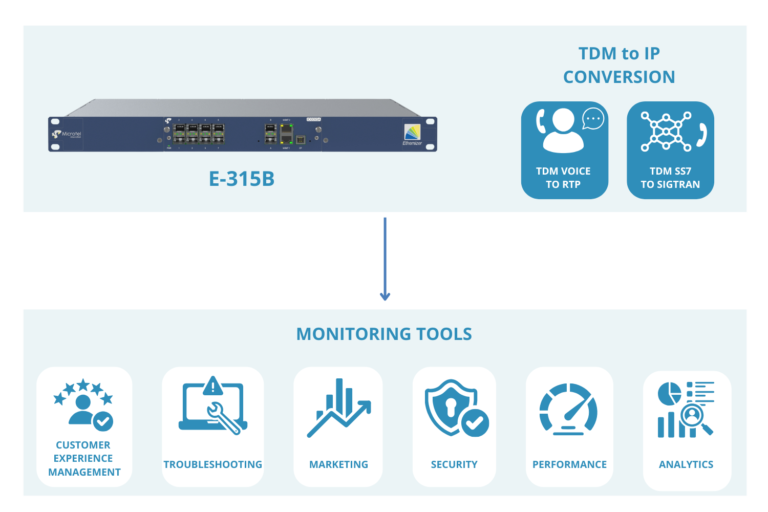Migrating from legacy TDM (Time-Division Multiplexing) systems to modern IP-based networks has become a critical step for telecom operators. This shift is driven by the need for more flexible, high-performance communication services, along with the cost savings that come from upgrading outdated infrastructure. While the transition to IP offers many advantages, it also presents technical challenges, especially when trying to integrate older systems with new IP networks.
Why Transitioning to IP Networks is Critical
Switching to IP-based networks is essential for telecom operators looking to stay competitive in an increasingly digital world. As manufacturers phase out support for old TDM equipment, operators face rising costs and the risk of system failures if they don’t upgrade. The transition is especially important for industries like public safety, healthcare, and transportation, where reliable communication is vital. These issues arise in several key areas:
○ End-of-life of TDM systems: many telecom operators are at a point where relying on legacy TDM infrastructure is no longer sustainable. As manufacturers discontinue support, the pressure to upgrade increases. This is particularly crucial for sectors that require uninterrupted service
○ Improved efficiency and reduced costs: moving to IP networks allows operators to run their networks more efficiently, saving on maintenance costs. IP networks offer better network management tools, making it easier to handle increasing data traffic and demands
○ Seamless coexistence of TDM and IP: solutions like the E-315B Ethernizer allow operators to manage both TDM and IP systems at the same time, ensuring that no service interruptions occur during the transition
○ Enhanced security and resilience: modern IP networks offer better security features than older TDM systems. By migrating, operators can protect their networks from cyber threats and improve their ability to respond to disruptions
Challenges of Legacy TDM Systems in an IP World
One of the biggest challenges in moving from TDM to IP networks is that legacy TDM systems often don’t work well with modern IP architectures. Traditional TDM networks, which carry both SS7 signaling and voice traffic, struggle to keep up with real-time performance monitoring. Conventional IP probes can’t always interpret TDM traffic, creating blind spots that make it harder to ensure high quality service for critical voice applications.
Using IP probes for monitoring instead of relying on TDM probes is a solution to this issue. IP probes allow operators to monitor traffic more effectively and improve network visibility.
E-315B: A Seamless Solution for TDM to IP Conversion
The E-315B Ethernizer is a powerful solution that solves these challenges. It provides a smooth conversion from TDM to IP, without disrupting services. The device converts SS7 signaling from MTP-2 to SIGTRAN (M2UA) and encapsulates TDM voice data into RTP (Real-Time Transport Protocol) while supporting STM-1 interfaces. This enables telecom operators to keep their important SS7 signaling in place while benefiting from the flexibility of IP networks.
By facilitating this conversion with minimal service interruptions, the E-315B allows TDM and IP systems to work together during the transition, avoiding expensive infrastructure overhauls.
The E-315B ensures seamless TDM-to-IP conversion for IP Probe to monitor voice quality
Key Benefits of E-315B for Telecom Operators
The E-315B provides several key benefits to telecom operators:
1. Enhanced network visibility: The device enables real-time monitoring of both signaling and voice traffic, giving operators full control over their networks and helping them manage traffic efficiently
2. Cost efficiency: Operators can upgrade to modern IP infrastructure without replacing all of their legacy systems, saving on capital expenses
3. Scalability: As traffic demands grow, the E-315B can handle more IP traffic without sacrificing performance
4. Advanced tunneling technologies: The device supports L2GRE and NVGRE tunneling, which helps operators route IP traffic from different TDM links to centralized monitoring systems, improving operational efficiency
E-315B as a Key Enabler of Telecom Modernization
The E-315B Ethernizer is a key tool for telecom operators looking to modernize their networks while maintaining the essential functionalities of legacy systems. Its ability to convert TDM to IP in real-time, while minimizing service disruptions, makes it an ideal solution for network transitions.
With its scalability, reliability, and smooth integration of legacy systems into modern networks, the E-315B offers a cost-effective and future-proof solution to the challenges of migrating from TDM to IP. As IP networks become more common, the E-315B helps operators maintain control, deliver uninterrupted services, and prepare their infrastructure for future demands.



